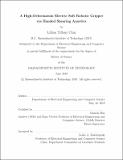A high-deformation electric soft robotic gripper via handed shearing auxetics
Author(s)
Chin, Lillian Tiffany.
Download1124856194-MIT.pdf (9.912Mb)
Other Contributors
Massachusetts Institute of Technology. Department of Electrical Engineering and Computer Science.
Advisor
Daniela Rus.
Terms of use
Metadata
Show full item recordAbstract
This thesis describes the development of a new class of electrically-driven soft robotic actuators built from handed shearing auxetics (HSAs). Soft robots - robots made out of more compliant materials such as rubber and silicone - are significantly more robust and safer than their rigid-bodied counterparts due to their intrinsic compliance. However, existing soft robots are mostly fluid-driven, causing them to be significantly more energy inefficient, susceptible to puncture and limited in controllability. To address these issues, we use HSAs to create compliant actuators without the inherent issues of pneumatic actuation. Through analysis of planar symmetry groups, we add chirality to shearing auxetic patterns, creating materials that expand with a handed bias when pulled in tension. This new metamaterial design enables us to create new structures that have a strong coupling between twisting and extension, letting us use traditional electric-based motors to get linear motion. In this thesis, we explain the theory behind this new class of auxetics, demonstrate how HSAs can be coupled to form compliant linear actuators, and characterize the actuators' performance in a variety of applications. This work culminates in an electrically driven soft robotic gripper which is significantly smaller, more energy efficient and more puncture resistant than existing pneumatic soft robotic grippers.
Description
This electronic version was submitted by the student author. The certified thesis is available in the Institute Archives and Special Collections. Thesis: S.M., Massachusetts Institute of Technology, Department of Electrical Engineering and Computer Science, 2019 Cataloged from student-submitted PDF version of thesis. Includes bibliographical references (pages 67-72).
Date issued
2019Department
Massachusetts Institute of Technology. Department of Electrical Engineering and Computer SciencePublisher
Massachusetts Institute of Technology
Keywords
Electrical Engineering and Computer Science.